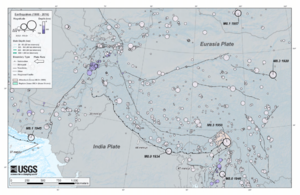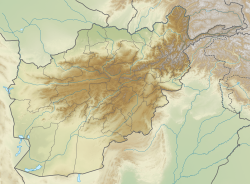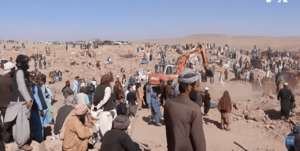2023 Herat earthquakes facts for kids

A village destroyed by the earthquakes
|
|
| UTC time | 2023-10-07 06:41:03 |
|---|---|
| 2023-10-07 07:12:50 | |
| 2023-10-11 00:41:56 | |
| 2023-10-15 03:36:00 | |
| ISC event | 635743372 |
| 635743376 | |
| 635746074 | |
| 635804203 | |
| USGS-ANSS | ComCat |
| ComCat | |
| ComCat | |
| ComCat | |
| Local date | 7 October 2023 |
| 7 October 2023 | |
| 11 October 2023 | |
| 15 October 2023 | |
| Local time | 11:11 AFT (UTC+4:30) |
| 11:42 AFT (UTC+4:30) | |
| 05:11 AFT (UTC+4:30) | |
| 08:06 AFT (UTC+4:30) | |
| Magnitude | 6.3 Mw |
| 6.3 Mw | |
| 6.3 Mw | |
| 6.3 Mw | |
| Depth | 14.0 km (8.7 mi) |
| 8.0 km (5.0 mi) | |
| 8.0 km (5.0 mi) | |
| 9.0 km (5.6 mi) | |
| Epicenter | 34°36′36″N 61°55′26″E / 34.610°N 61.924°E |
| Type | Thrust |
| Areas affected |
|
| Max. intensity | VIII (Severe) |
| Casualties |
|
In early October 2023, a series of strong earthquakes hit Herat Province in western Afghanistan. There were four main earthquakes, each measuring Mww 6.3, along with many smaller aftershocks. The first two big quakes happened on October 7, followed by two more on October 11 and October 15 in the same area.
These earthquakes caused a lot of damage. The World Health Organization (WHO) reported that nearly 1,500 people died and over 2,100 were injured. Many homes were destroyed, leaving thousands of people without shelter. The earthquakes happened when Afghanistan was already facing a difficult humanitarian situation. Many aid groups were working to help, but they needed more funds.
Contents
What Caused the Earthquakes?

Afghanistan sits in a complex area where huge pieces of the Earth's crust, called tectonic plates, are constantly moving and pushing against each other. These plates include the Arabian Plate, the Indian Plate, and the Eurasian Plate. When these plates collide, they can cause stress to build up in the Earth's crust. When this stress is released, it causes earthquakes.
The western part of Afghanistan has different sections of crust that have joined over millions of years. There are also large cracks in the Earth's surface, called faults. The earthquakes in Herat were caused by a type of faulting called thrust faulting. This happens when one block of the Earth's crust pushes up and over another. This region has had several strong earthquakes in the past, showing it is an active area.
The Earthquakes Happen
The first major earthquake, with a magnitude of 6.3, struck at 11:11 AM local time on October 7. Just eight minutes later, a magnitude 5.5 aftershock hit. Then, at 11:42 AM, another powerful 6.3 magnitude earthquake occurred, followed by a 5.9 aftershock.
On October 11, a third 6.3 magnitude earthquake shook the same area. A fourth earthquake of the same magnitude happened on October 15. The United States Geological Survey (USGS) confirmed that all four main earthquakes were caused by shallow thrust faulting. This means the ground moved along a fault that was not very deep underground. On October 28, a magnitude 5.0 event also hit the area.
Scientists used satellite data to study the ground movement. They found that an area about 30 kilometers (18 miles) long and 15 kilometers (9 miles) wide was lifted up by the earthquakes. This showed that the quakes were likely caused by a "blind thrust fault," which is a fault that doesn't reach the surface of the Earth.
How the Earthquakes Affected People
October 7 Earthquakes
The earthquakes on October 7 caused a lot of damage and loss of life. The World Health Organization reported 1,482 deaths. Sadly, 90 percent of those who died were women and children, as they were often inside their homes when the buildings collapsed. Most men were outdoors at the time. About 2,100 people were injured.
Many villages were severely affected. Some, like Nayeb Rafi, were almost completely destroyed, and a large part of their population died. In Siah Aab, 300 people lost their lives. Over 21,500 houses were completely destroyed, and another 17,088 were badly damaged. Many of the homes were made of mud, which made them more likely to collapse.
The United Nations estimated that 43,300 people were directly affected, and 114,000 people needed urgent help. Even historic buildings in the city of Herat, like medieval minarets, were damaged.
Later Earthquakes
The earthquake on October 11 killed three more people and injured at least 169. Many people were already living outside because their homes were damaged from the first quakes. This third quake destroyed all 700 houses in a village called Chahak, which had survived the earlier quakes. It also caused a landslide that blocked a main highway.
The earthquake on October 15 caused four deaths and 160 injuries. It destroyed more villages and caused power outages in most of Herat Province. The earthquake on October 28 injured 13 people and caused more property damage.
Helping Those Affected
The earthquakes happened when Afghanistan was already dealing with many challenges, including years of conflict and drought. Many aid organizations quickly stepped in to help.
- The World Health Organization sent ambulances and medical teams to transport injured people to hospitals.
- Doctors Without Borders set up medical tents at Herat Regional Hospital to treat patients.
- The Afghan Red Crescent Society sent rescue teams and provided temporary shelters, blankets, and other essential items.
- UNICEF distributed hygiene kits, family kits, winter clothes, and household items.
- The World Food Program prepared food packages for thousands of families.
- Many people, including military personnel and volunteers, worked tirelessly to rescue those trapped under rubble, often using their bare hands.
Hospitals in Herat were overwhelmed with the number of injured people. Health workers worked hard to care for everyone, even setting up beds outside the main hospital. Teams of doctors and nurses were also sent from other provinces to help.
Rescue efforts continued for days after each earthquake. By October 12, most search and rescue operations were completed, but health and rescue groups stayed in the area to continue helping.
What Happened Next
Many mass funerals were held in the affected villages for those who died. The Supreme Court of Afghanistan even ordered the release of 473 prisoners from a prison in Herat because cracks were found in its walls, making it unsafe.
Thousands of people became homeless and had to live in temporary tents in parks and open spaces, turning Herat Province into a "tent city." The constant aftershocks made survivors feel very anxious and scared. Many people visited hospitals not just for physical injuries, but also for mental health support.
As winter approached, there was a big worry about people living in tents in the cold. The Taliban government announced plans to build new houses for survivors before winter arrived. By January 2024, at least 3,000 houses had been built in one district, using new building methods. However, hundreds of thousands of people were still living in tents. Nearly 300 schools were also damaged, affecting 180,000 students.
International Help
The Taliban government asked for international help. Many countries and organizations offered support:
- Australia: Pledged AU$1 million in aid.
- Canada: Said they were ready to support the Afghan people.
- China: Offered $200,000 in aid through the Chinese Red Cross.
- European Union: Approved a €3.5 million aid package.
- Germany: Pledged €60 million for humanitarian aid.
- Indonesia: Sent aid worth Rp 22.104 billion and various items.
- Iran: Sent rescue teams, tents, blankets, and food packages.
- Japan: Provided US$3 million to international organizations and US$1.46 million to NGOs.
- Kazakhstan: Sent humanitarian aid including food, tents, and medicines, and deployed rescue personnel.
- Kyrgyzstan: Sent humanitarian aid.
- Pakistan: Prepared to send relief items and a medical team, though some aid was later rejected.
- Qatar: Sent humanitarian aid.
- Saudi Arabia: Sent humanitarian aid.
- Singapore: The Singapore Red Cross pledged US$50,000.
- South Korea: Provided US$1 million.
- Tajikistan: Provided US$1.5 million.
- Turkey: Sent an aircraft with emergency relief materials.
- Turkmenistan: Donated medical equipment, clothes, and food.
- United Arab Emirates: Delivered food packages, tents, and aid packages by aircraft.
- United States: Announced US$12 million in urgent humanitarian assistance.
- Uzbekistan: Sent 100 tons of humanitarian aid.
The international response was sometimes slow because many countries were hesitant to work directly with the Taliban government. Also, the 2023 Israel-Hamas War started around the same time, drawing attention and resources elsewhere. In February 2024, the UN estimated that about $400 million was still needed for recovery and rebuilding efforts.
See also
- List of earthquakes in 2023
- List of earthquakes in Afghanistan
- Lists of 21st-century earthquakes
Images for kids





